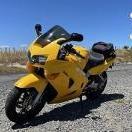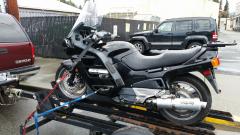-
Posts
1,805 -
Joined
-
Last visited
-
Days Won
59
Content Type
Forums
Profiles
Gallery
Blogs
Downloads
Events
Everything posted by Terry
-
The VTR and 5G definitely use the same bearings, but the steering stem length could be different, as could the yoke offset. I put 6G yokes and CBR600F4 forks onto my 5G as I was confident the frame/geometry was largely unchanged between the 5 and 6G, and the only issue I had was getting the steering lock pin to align with the socket in the frame, which required the 5G lock mechanism to be shimmed down off the 6G triple.
-
A bigger diameter MC should give you a more wooden brake as there is less hydraulic advantage over the calliper pistons; not a bad thing for a rear brake in my view.
-
The axle and spacers do not need to change. VTR cartridges/fork caps are much the same as VFR certainly from a dimension, threadsize etc perspective, and the damping parts are just the same (with an added adjustable rebound bleed) so just as poor, and you ought to at least get a GoldValve for compression. VFR springs would be OK but you may need to adjust the spacer length, some PVC pipe is perfect for this. Or buy some decent springs from Somic, Racetech etc that are specific to your weight. Use of CBR calipers requires removal of a little of the lower mounting bracket on the fork, a few minutes with a hand file. They also need to be spaced off the fork by something like 2-3mm, I used a couple of SS washers superglued in place. You should definitely get a master to match the calipers, to keep the correct hydraulic ratio. You can't use a VTR guard as the fork leg spacing is different on the VFR (wider) so use your VFR guard and make up some small brackets to mate to the VTR legs.
-
I've had stock 5G, modified 5G (replaced springs and Gold Valves) and then modified 600F4i forks on my 5G. Bang for buck, the modified 5G fork is pretty good and maybe 95% of what the 600F4i fork offered. The latter seemed to have better quality/design bushings that made for lower friction and a better ride, and the 43mm vs 41mm stanchions were definitely less prone to flex. I never got a lot of value from the external adjusters as they fall into the set and forget category. Using VTR1000F caps/damper rods will get you adjustable rebound if you wanted that for not much $$.
-
You will get value from the suspension upgrades every time you ride. It will be safer, more relaxing and more comfortable. I have never regretted suspension $$ (and I've done them on all my bikes). Ducnut was 100% correct: "You’ve had decent suspension and, now, have that experience to compare to something stock. You’re never going to be happy with stock components, from now on. "
-
With a K&N oil filter fitted, the answer occasionally is from the inside to the outside....
-
I agree with JZH, the ring is the antenna only, and the ECU has to be instructed to accept the code transmitted from the IP46 chip mounted in the key. I'd be very careful buying an ECU UNLESS it comes with at least one known-to-function chip/key. To program acceptance of a new key, you first need to have an accepted key. I presume Honda will sell you a new ECU plus keys as a set.
-
I've got the manual for that and there is no code for 6 blinks (nothing for 3, 4 5 or 6). A long blink (1.3 seconds) is equal to a value of 10, and if there is more than one fault then it blinks for the lowest number fault first, then second etc. My guess is you have more than one fault. You could clear the fault register and run the bike and see what new fault occurs. If you started the bike with any sensor disconnected during maintenance then it will record that as a fault. I can give you a link to the manual if you don't have it.
-
Just my opinion but I think that would be a Bad Idea. On an exhaust system the wrap gets hot and dries out, but on a frame I'd expect it will trap water and accelerate corrosion.
-

I made custom VFR brake / clutch reservoir caps!
Terry replied to BassNotBass's topic in Modifications
Hope you got an A+, I really like those. Good choice on the logo/font. -
The springs are typically 35mm OD so you need tubing that is close to that; make sure you use the washer between the spring and the spacer otherwise the spring will chew up the spacer. The fork tubes are 41mm OD and (my guess) about 1 mm wall thickness so they would be close to 39mm ID. At 35mm the spacer would fit with 2mm clearance all round.
-
I think the most significant difference between those two is the extra 0.1 x 17 shim, this will make the shim stack slightly stiffer but not by much as a 0.1mm shim is less than 1/3rd the stiffness of a 0.15mm shim.
-
Factorypro do a good info page for CV carb setup, and are where I bought the emulsion tubes for my 900. You should be able to pull the carb tops off and the slides out, and just look at the brass tubes in the carb floor. The tubes can be replaced from inside the float chamber.
-
I had an RF900 for 18 years, they are a good solid machine but a little uninspiring next to a V4. Have a look at the emulsion tubes in the carbs, mine wore oval over 50,000km and the fuel economy went to crap (plus fowled plugs at low revs) but it was an easy fix.
-
I have a 99 (no cat) with a bit over 100,000km on it. It has well-balanced throttle bodies, well-maintained K&N filter, new plugs, correctly working thermostat ( usually sits at 78-80C except in traffic) and in-spec valves. I typically see 270-290km before the last fuel bar starts flashing, and that equates to 16-17 km/L. I thought that was a bit low and have replaced the FPR but that made no difference. It is pretty sensitive to riding style, lots of point and squirt will see that drop, and highway droning would make it a bit higher (but less fun).
-
-
That's another 5km/hr added to your top speed right there MD. Take it easy on the first test ride!
-
Hi Terry, Thank you for your donation of 15.00 USD. We look forward to improving the forums with your donation. Thanks VFRDiscussion
-
I've use the HotCams 7.48mm shim for my engines with no issues at all. Just note that they come in 0.05mm increments, where the OEM shims are available down to 0.025mm increments. The difference here will be apparent to the OCD sufferers on the forum, as the allowable range is +/-0.03mm. That means in practice there is only one HotCams shim thickness that will get you into the allowable range, and it might be at the very top or very bottom of the range; if you want to get right in the middle, that may not be possible. The HotCams kits (mine at least) came with 3 of each size. From memory I needed 4 of one particular size...YMMV. They do sell refill kits with 5 of a specific size, once you know what you need it is easy to top up the required bits. I also have a cheap set of digital calipers which are really useful to check the old and new shims thickness; sometimes the thickness markings get worn off or obscured.
-

Using H4 headlight bulbs in 1998 - 2001 VFR800: any issues?
Terry replied to garcenw's topic in Modifications
I doubt you would have any issue with 55/60W bulbs as these are very common in other headlights so it seems likely that the standard H4 plug would be specified to be used with these. I have had past experience of a plug melting issue with a single 80/100W H4 bulb however. The headlight fuse is 20A so that will be enough for 240W total at 12V; as you switch from low to high I guess it is possible you could have both sets of filaments live instantaneously so 230W max, just below the fused rating. Like Maxswell I happily used 55/60W bulbs in my bike without any consideration for its electrical health. -
I guess it is obvious that the pinch bolt needs to be tight to stop the eccentric rotating in the rear hub. What is not so obvious is the bolt must have the washer/brake hose carrier installed, if not the bolt can bottom out without pinching hard on the eccentric.
-
I've got APE brand manual CCTs in my VTR1000F, on that bike these are a compulsory acquisition as failure is sudden and deadly to the valves. I manually tensioned them with the cam covers off so they have 7mm of freeplay between the cam sprockets.
- 1 reply
-
- 2
-

-
Does your FI light blink or stay on? Have you tried the diagnostic procedure to read the malfunction does?
-
I don't think there is specific torque for all those bolts; the generic fastener setting in the manual is 10 N-m for a 6mm flange head bolt. BTW, you don't have to drain the oil for a clutch plate replacement, if the bike is on the sidestand the oil level is below the opening.
-
12 N-m for the springs. What do you mean by the clutch plate cover?




